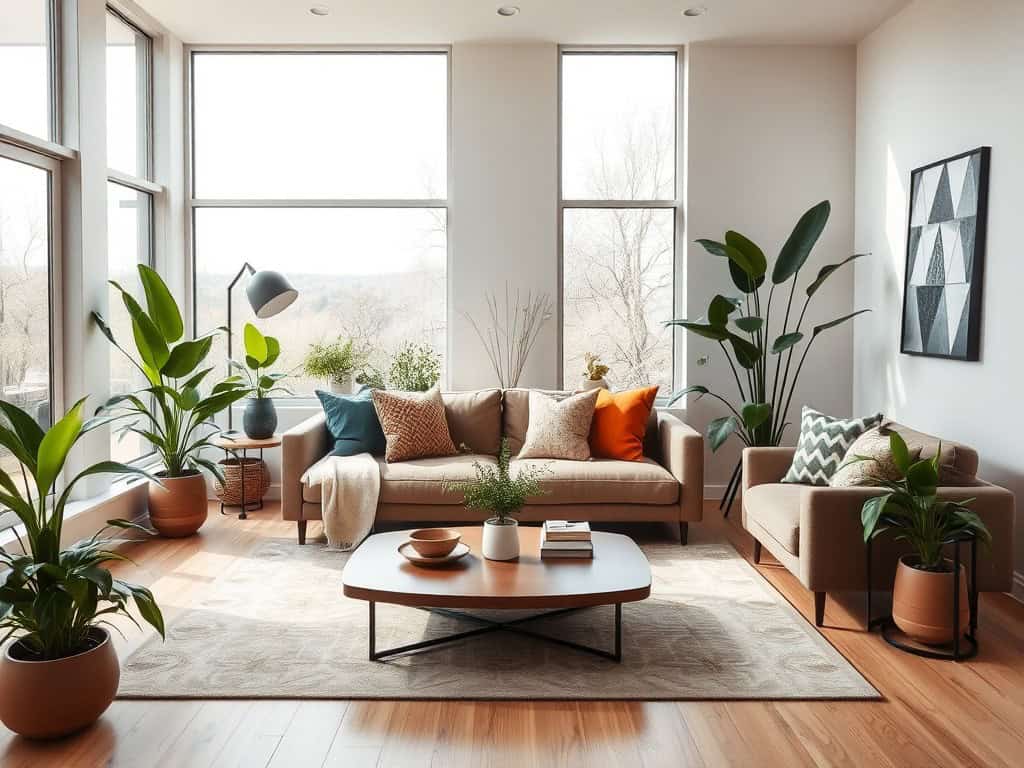You know that sinking feeling when you walk into your small, narrow living room and everything feels cramped and chaotic—no matter how you rearrange the furniture? I’ve been there too, and with urban living spaces getting even tighter in 2025, it’s a challenge countless homeowners face in making their main hangout spot both functional and inviting.
That’s why this post dives into 17 clever ideas, from smart decor hacks and cozy layouts to multifunctional furniture that works for any budget or style, helping you transform overwhelm into a stylish, comfortable haven.
Get ready to reimagine your space with easy, empowering tips that will spark joy and change how you live!
Key Takeaways
Smart furniture placement helps divide small, narrow living rooms into useful zones. Use rugs, open shelving, and straight-back or corner sofas to create cozy areas for relaxing, dining, and reading. Designer Lisa Adams suggests sectionals to avoid the “corridor effect.”
Choose slim furniture with tapered legs and multifunctional pieces like storage ottomans or sleeper sofas. These keep the room uncluttered while adding extra seating or hidden storage space.
Mixing types of lighting—such as wall sconces, table lamps, floor lamps, and dimmable bulbs—creates a warm feel. Using at least three points of light makes your space look bigger and more welcoming.
Light neutral walls like eggshell white and soft sage reflect sunlight to make rooms brighter. Bold paint on one accent wall can add character without making the area seem cramped.
Mirrors help bounce light around tight spaces so they look larger. Sheer curtains highlight windows for an airy feel; blinds offer privacy while letting in more natural light for a spacious look.
Table of Contents
Layout Tips for Small Narrow Living Rooms
Careful furniture placement changes how a room feels—use couches, armchairs, and rugs to split the space into useful sections. Even small living rooms can feel cozy and open with thoughtful home decor inspiration.
How can I break a small narrow living room into functional zones?
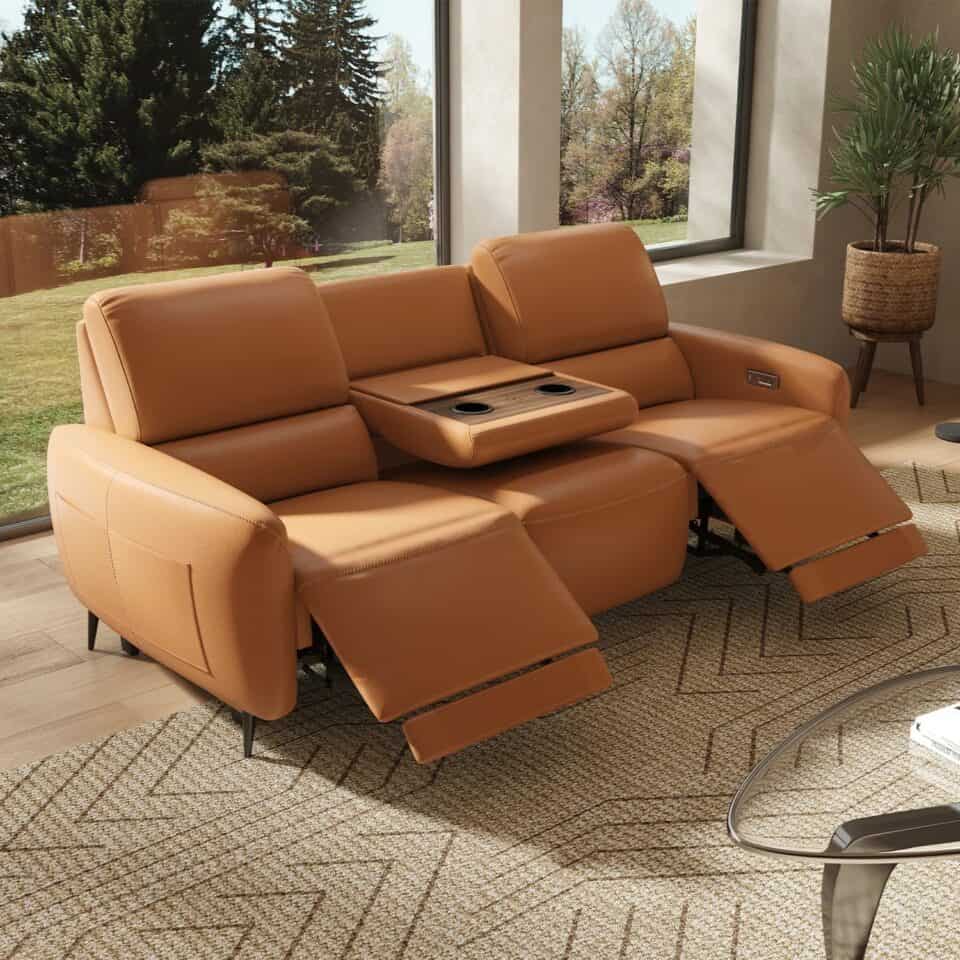
Defining clear zones in a small, narrow living room makes the space feel bigger and more useful. I’ve tried many of these tips at home to turn one long area into a cozy living room that works for relaxing, reading, and dinner.
- Place a large rug or two smaller rugs to separate seating from dining areas; this trick helps make each zone stand out.
- Choose open-concept shelving to act as a divider without blocking light or making the room feel boxy; bookshelves with open backs work well here.
- Use sofas or couches with straight backs to mark off the conversation area while saving every inch of depth possible in tight spaces.
- Arrange armchairs on either side of your main couch for symmetry; this furniture arrangement creates balance and a natural flow between zones.
- Add multifunctional pieces like an ottoman that acts as both coffee table and extra seat; these smart additions multitask without filling up the floor.
- Define the primary purpose for each part using focal points such as a mantelpiece, statement art, or even a unique zero gravity chair for relaxing after long days.
- Hang breezy curtains or use soft fabrics to create texture between areas—for instance, knitted throws over couches can signal the lounging spot.
- Use lighting to highlight zones: pendant lights above the dining spot and lamps near reading chairs improve illumination while visually separating functions.
- Paint short walls in bold colors if you want to add character; this instantly defines where one activity zone ends and another begins.
- Incorporate vertical storage units against long walls so floors stay clear; tall bookcases or floating shelves organize clutter while freeing up walkways.
These steps help you get more function from your home decor while keeping things stylish and uncluttered—a must for any modern cozy living room setup!
Why use a straight-back sofa to save space?
After creating zones in a small, narrow living room, focus on furniture that works hard without taking over. Straight-back sofas give you more seating and keep the space looking airy.
Their slim arms mean extra inches for walking or adding tables.
Light neutral covers help your sofa blend in and make the whole room feel brighter. Pieces with straight backs sit close to walls, leaving more open floor for foot traffic or kids’ play.
Try arranging two straight-back sofas across from each other; this layout creates balance and makes conversation easy.
Choosing models with tapered legs lets light flow under the sofa, showing off more of that lovely open-plan flooring. For even greater flexibility, check out a recliner sofa that’s both comfy and space-smart—ideal if you’re tight on square footage but want style too.
How does a corner sofa help avoid a corridor effect?
A straight-back sofa keeps things neat, but for a narrow living room, a corner sofa goes further by solving the corridor effect. Placing it snugly against two walls shapes an inviting nook and frees up your central floor area.
The open space left in the middle means you can move around with ease—no cramped pathway here.
Corner sofas also keep conversation close. “A well-placed sectional draws people together while opening up the rest of the room,” says designer Lisa Adams. With a low backrest, these sofas let more light bounce through and make your living area feel bigger than it actually is.
Visually, they break up that long tunnel look by drawing attention to their cozy seating spot instead of just highlighting mirrors or blank stretches of wall—giving you function and comfort without any cluttered feeling at all.
How do I choose the best furniture for a small narrow living room?
Finding the right seating and tables can change how your space feels. Think small-scale sectionals, storage ottomans, and nesting side tables to make every inch work harder.
Why choose furniture with tapered legs?

Slim, tapered legs on sofas and chairs make any small living room feel lighter. They expose more of the floor, which tricks your eyes into seeing more space. This works well in tight areas where you want each piece to breathe a little bit.
Furniture with these angled wooden or metal legs helps stop that closed-in look many women try to avoid.
It is also easier to rearrange these pieces when you have guests over since most weigh less than heavy block-style furniture. I picked out a mid-century modern coffee table with tapered legs for my own narrow den last year; it made cleaning under the table much simpler and kept my floors in view at all times.
The style feels fresh while fitting right in with trendy décor themes like minimalist and Scandinavian design trends from 2023, so your room looks both stylish and open.
What are the benefits of multifunctional furniture pieces?
Tapered legs help keep things airy and easy to clean, but multifunctional furniture takes space-saving a step further. A sleeper sofa can serve as both seating by day and a guest bed at night—my own small living room felt twice as useful after adding one.
Ottomans with hidden storage hold blankets or magazines, cutting down on clutter. Storage benches define activity zones without taking up extra square footage.
Convertible tables let you switch from coffee table to dining desk in seconds, making the most of every inch. Shelves that reach upward use vertical storage, freeing precious floor space for play or relaxing evenings.
Pieces like a wall-mounted fold-out desk let me work efficiently without sacrificing comfort or style in my narrow room. These choices prevent rooms from feeling cramped while keeping everything organized and within reach.
How can a storage sofa add utility to my living room?
Multifunctional furniture helps make every inch count in a small narrow living room. Storage sofas boost utility by offering hidden space for blankets, toys, or even board games under the seat.
These two-in-one seating solutions help cut clutter and keep floors clear.
Strategic placement of a storage sofa also improves traffic flow by keeping walkways open and tidy. Choose light-colored upholstery to reflect more sunlight; this makes your room look brighter and feel bigger.
“A clean home is a happy home,” says interior designer Emily Clark from Home Design Studios, showing how easy tidy spaces lift moods. Pairing your storage sofa with an ottoman that has built-in storage gives you even more spots to stash things out of sight while adding comfy extra seating for guests or family movie night.
Regular decluttering works well here; it’s simple to toss items into their new hidden spot when company calls or at the end of a busy day.
How do I decorate a small narrow living room effectively?
Add bold fabric cushions, a soft area rug, and balanced wall art to make your small living room feel bright and inviting—discover easy ways to style and refresh your space next.
How can fabrics and rugs add texture to the space?
Soft throws, velvet cushions, and thick area rugs quickly make any narrow living room feel more inviting. A large rug under the sofa unifies furniture and helps break up that long hallway effect.
I once layered a chunky knit blanket on my own couch and noticed it warmed up the space and drew attention to my cozy nook.
Mixing textures like chenille pillows with low-pile carpets gives each spot its own identity. Rugs can help define separate zones, especially in open-concept layouts. Durable materials work best for spaces busy with kids or guests.
Multiple fabrics add depth and style without cluttering, making your small space look thoughtfully decorated every day.
How do I use symmetry to create balance in the room?
Pairing matching chairs or sofas around a focal point, like a fireplace, helps counter the long shape of a small living room. Placing identical side tables and lamps on each end gives your space an even look.
I have tried this with two armchairs and a round coffee table; it made my narrow room feel complete and peaceful.
A large area rug in the middle pulls everything together. Avoid using several small rugs since they make the room seem choppy. Always check that furniture fits well, as big items crowd small areas while tiny pieces get lost visually.
Keeping similar colors on both sides boosts comfort for everyone who visits.
Symmetry makes your living room calm by balancing shapes and shades.
Why incorporate vertical stripes to add height?
Vertical stripes in wallpaper or decor make ceilings look taller. This trick helps your small living room feel more spacious and open right away. Pale vertical stripes reflect sunlight, so the whole area becomes brighter and airier.
Rugs with vertical patterns can also stretch the eye upward, making even a narrow space seem longer.
This pattern works well with tapered furniture legs to keep everything light and fresh. A simple color palette combined with these lines makes the design calm but stylish. Vertical stripes can act as a focal point too; they catch attention without making things busy or overcrowded.
Add visual interest by using them on one wall or through accent pieces for instant height and style in your space.
How can oversized artwork enhance visual impact?
Oversized artwork acts as a strong focal point and can draw all eyes to one spot in your living room. A large canvas or print gives your space more personality, making even awkward layouts feel bold and inviting.
Big art pieces create depth; they add layers that make small, narrow rooms feel much bigger than they are.
I once hung a tall painting with bright colors above my sofa. It added height to the wall and helped the room seem taller at once. One big art piece also reduces clutter since you do not need many small items competing for attention.
This keeps your decor simple and brings harmony to the whole space. Placing oversized artwork by a reading nook or along one long wall helps define different zones, giving each area its own vibe without breaking up flow.
If you pick vertical designs, these will stretch your walls upward; this makes any narrow living room look open and airy right away.
What are the best lighting strategies for small narrow living rooms?

The right lighting choices can make a tight room feel warmer and more welcoming. Try using dimmable bulbs, pendant lights, or sconces to highlight special features and set the mood you want.
How do I layer lighting for the right ambiance?
Good lighting turns a small narrow living room into a cozy spot. Mixing different types of lights shapes the mood and adds depth to your space.
- Start with ambient lighting from ceiling lamps or flush mounts, which gives the whole room a soft glow and keeps dark corners away.
- Add task lighting using table lamps or wall sconces near reading chairs or sofas; these help you see clearly while working on crafts or reading.
- Place accent lights above shelves, behind artwork, or along architectural details to draw attention and add dimension.
- Choose dimmable bulbs for overhead lights; now you can adjust brightness for movie nights, parties, or relaxing after work.
- Pick fixtures that match each other in style and color to create a unified look across your living room.
- Set up at least three points of light around the room for balance; my own living room feels bigger with this trick because it avoids big shadows.
- Use mirrors to bounce natural and artificial light around, making everything look brighter and more open without adding more lamps.
- Try mixing floor lamps with table lamps for a layered effect; this combo helps make every part of your sofa nook feel comfy after sunset.
Following these lighting tips makes even tight spaces lively, stylish, and welcoming—no matter the shape of your living room!
Why use wall lights to save floor space?
Careful layering, like mixing ceiling lights, table lamps, and sconces, gives you control over mood. But if every inch matters in your small living room, wall lights step up as true space-savers.
Wall-mounted fixtures free precious floor area that bulky lamps or big shades would fill. A simple brass sconce above a reading chair lets you skip the side table lamp completely. I used a pair of adjustable wall lights in my own narrow living room last year—they made moving furniture around much easier and kept the space clear for walking.
Wall lighting adds an open feel too; it draws your eyes upward along with mirrors or lighter paint colors to create an airy look. For flexibility, try dimmable options so you can set soft light for movie night or brighten everything while reading.
Keeping your floor clean leaves more space for storage baskets or even extra chairs when guests drop by!
How can floor and table lamps create a cozy atmosphere?
Floor and table lamps give off a soft glow that makes small, narrow living rooms feel warm and inviting. Placing them in different spots helps set up activity zones, like a reading corner near an armchair or gentle light by the sofa for movie nights.
Use bulbs with warmer tones to add extra comfort; cool lights can feel harsh in close spaces.
Mixing lamps of different styles and heights brings both charm and personality into the room. Dimmable options allow you to change the brightness whenever you want more relaxation or focus.
Layered lighting from several lamps smooths out shadows, filling every spot with even warmth while saving precious floor space at the same time as wall lights do.
How do I pick smart colors for a small narrow living room?

Choosing the right paint colors—like eggshell white or soft sage—can instantly make your narrow living room feel bright, open, and full of style, so keep reading for color tips that work.
Why use light neutrals and pastel shades?
Light neutrals and pastel shades help a small living room feel bigger than it is. These colors bounce natural light across your space, so the room looks brighter and feels more open even if you only have one window.
Pale walls, like cream or blush pink, reflect sunlight better than dark hues do. This creates an airy look instead of shadows that make things seem cramped.
A soft color palette also calms the eye and pulls everything together for a tidy effect. Light-colored furniture blends with pale backgrounds to stop visual clutter. Pastel accents—think mint cushions or powder blue throws—give personality without making the design too busy or heavy.
Vertical stripes in gentle tones can lift the ceiling visually; your narrow living room will appear taller and more spacious every day you walk in.
When is bold paint a good choice for character?
Pastel shades create a soft, airy feel in tight living rooms. Sometimes, though, a small space craves more personality and energy.
Bold paint works great for making a focal point or adding strong character to narrow living rooms. I once used deep blue on one long wall behind the couch. This color instantly became the star of the room and made my artwork pop.
Darker hues like emerald green or navy blue can wrap around your walls to add warmth and drama without crowding the space; these shades also hide minor marks better than white.
Try bold paint colors to highlight different zones in an open plan setting—a sunny yellow nook signals where morning coffee happens, while a rich charcoal creates an inviting spot by the TV stand or floating media center.
If you want visual interest but worry about going too dark everywhere, painting just one accent wall does wonders. Bold colors express taste and turn even tiny rooms into memorable spots for relaxing with friends or curling up with a book.
How can contrasting colors define separate zones?
Contrasting colors help split a small narrow living room into clear areas for different tasks. For example, I used a navy rug under my reading chair and a soft beige one by the couch.
This simple change made each spot feel like its own zone. Choose two or three shades that look good together, but still stand out from each other.
A palette with only three main colors keeps things unified while letting you highlight special spots. Lighter hues can make spaces seem larger and more open, while deeper tones give depth to corners or nooks set aside for hobbies or work.
Place accent pillows in bold colors on one sofa, then use softer throw blankets elsewhere to reinforce the separation without causing clutter or chaos in your decorating plan.
Using Mirrors and Windows to Maximize Space
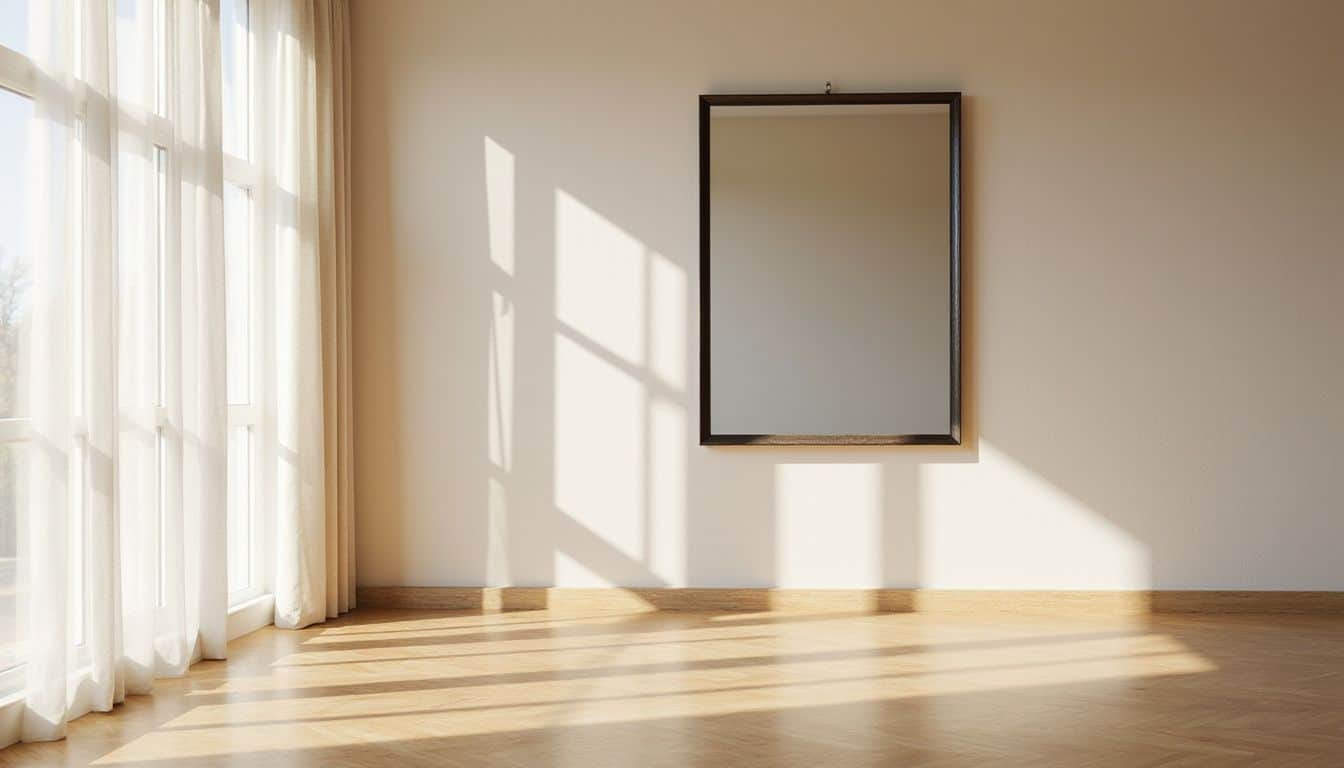
Mirrors bounce light around, making your living room appear larger and brighter. Sheer curtains highlight your windows, creating an airy feeling that draws the eye outside.
How do mirrors create the illusion of a larger room?
A large glass mirror on one wall reflects both light and decor, making a small narrow living room feel more open. Reflections from mirrors bounce natural light across the space so everything seems brighter and airier.
Hanging a big frameless mirror behind your sofa can double the sense of depth, which breaks up that cramped or boxed-in look.
Proper placement of reflective surfaces also improves visual flow in small spaces like apartments. If you position your mirror to face a window or attractive view, it adds even more interest to the room while increasing openness.
Use pale walls and simple furniture for better results; these neutral shades let every ray of reflected sunlight count. Keep clutter away to make sure this effect lasts—too many items can block what you gain from mirrors completely.
How can breezy curtains draw attention to windows?
Breezy curtains let natural light fill the living room. Sheer fabrics, like voile or chiffon, keep things bright and soft at the same time. I use long, floor-length panels to make my windows look taller, which helps my small space feel more open.
Light shades—white or pale gray—work well with pastel walls and create a fresh look that pulls your gaze straight to the window.
Layering these airy curtains with a mirror nearby doubles their effect; sunlight bounces around and makes both the window and room shine. The soft movement of loose curtain fabric adds gentle style while not blocking any outside views.
This simple trick often becomes my favorite way to highlight windows in tight spaces without extra clutter.
Why install blinds to open up the room?
Blinds make a small narrow living room look bigger and brighter. They give you better control over light and privacy compared to heavy curtains. I noticed my own space felt taller right after swapping in white wooden blinds last spring.
The clean lines create a modern, simple look that lifts the eye upward, making ceilings feel higher and walls appear wider.
Uncovered windows invite more sunlight into the room; this boosts brightness during the day and improves how spacious everything feels, especially with pale or pastel color palettes on walls or furniture.
Blinds work well with other window treatments like sheer drapes for even more softness without blocking natural light. Choosing colors for blinds that match your furniture ties everything together so your living area looks neat, fresh, and open every day.
Flooring and Rugs to Enhance Small Living Rooms
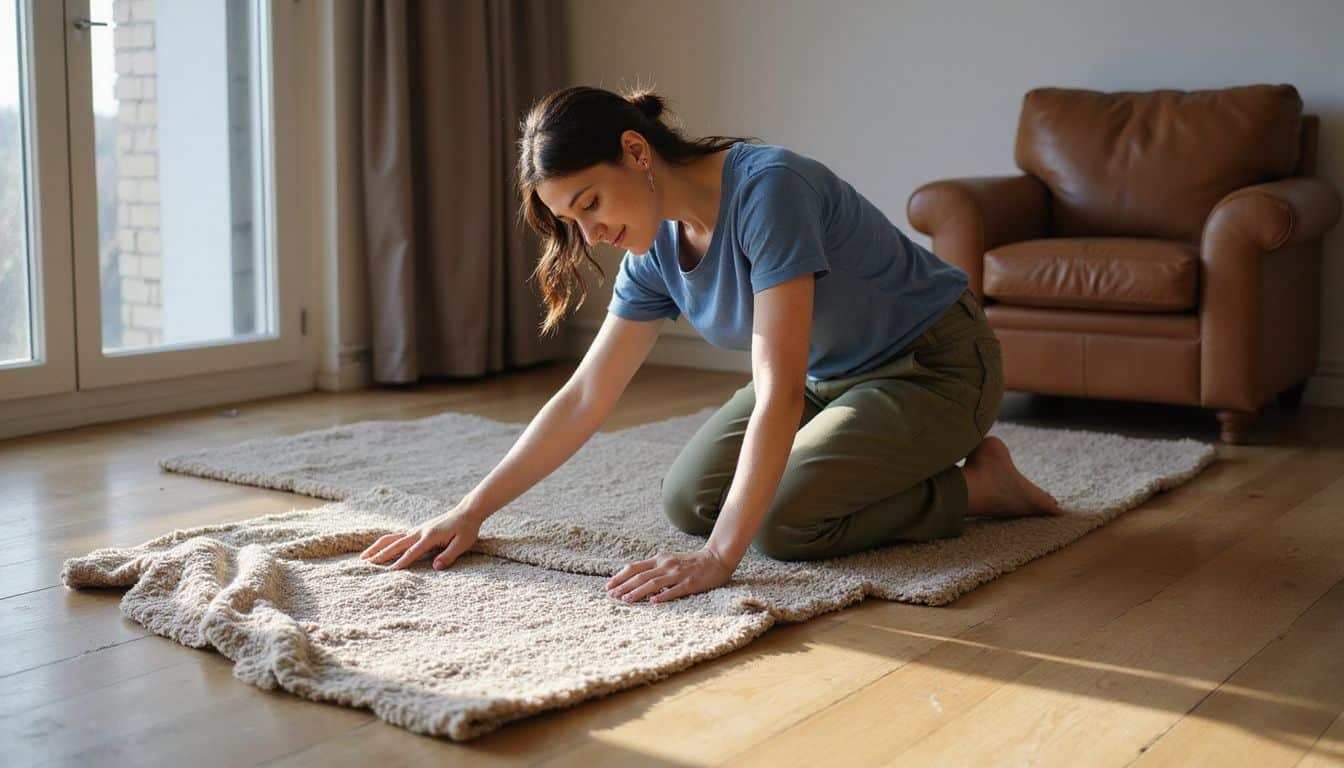
Wood floors and broad area carpets work together to spread light, making the whole living space feel open. Mixing woven mats or soft pile rugs can set apart seating spots without crowding the room.
How does light-colored flooring make a room look bigger?
Light-colored flooring, like pale oak or soft maple planks, reflects more sunlight and lamp light. This extra brightness bounces around the room and chases away dark corners. Small spaces feel larger when your floor glows with creams, whites, or gentle pastel tones because these colors create an open look.
Softer patterns in area rugs can also help your narrow living room seem less cramped; they don’t break up the space visually. Using a cohesive color palette of light neutrals ties everything together for an airy vibe.
Modern designers love light wood floors in tight spaces, as this trick always makes rooms brighter and more inviting. Now that you know how flooring tricks the eye, see why choosing a large-scale rug works wonders for small areas too.
Why choose a large-scale rug to anchor the space?
A large-scale rug can make a small, narrow living room feel bigger and more balanced. It gives the space a cozy foundation while tying all your furniture together. Smaller rugs often look cramped in tight rooms, but big ones stretch past the seating area to create flow and visual unity.
Choose a rectangular rug to highlight the length of your room; this helps open up the space visually.
Using a bold or textured rug also brings warmth underfoot and adds character as a focal point, making your room both stylish and comfortable. Rugs define zones without needing extra walls or dividers—perfect for homes where you want every square foot to work hard for you.
By anchoring seating with one large piece, you ensure every part of your living area feels connected yet welcoming.
How can different rug textures define areas?
Mixing rug textures quickly divides a small narrow living room into clear zones. Place a plush area rug under the seating spot for warmth and comfort, while using flat-weave rugs in high-traffic areas like walkways or reading corners for durability.
Try layering styles and combining wool with cotton to add depth and interest without making the space feel busy.
Use vertical patterns or stripes on your rugs to stretch the look of your room, giving it more height. Extend each rug beyond its main furniture piece to keep things balanced and connected across zones.
Soft rugs in gathering spaces make these spots feel welcoming; sturdy mats under tables or by entryways handle daily use with style. Light flooring adds brightness, so now think about clever storage ideas that help you save even more space.
What are effective storage solutions for small living rooms?
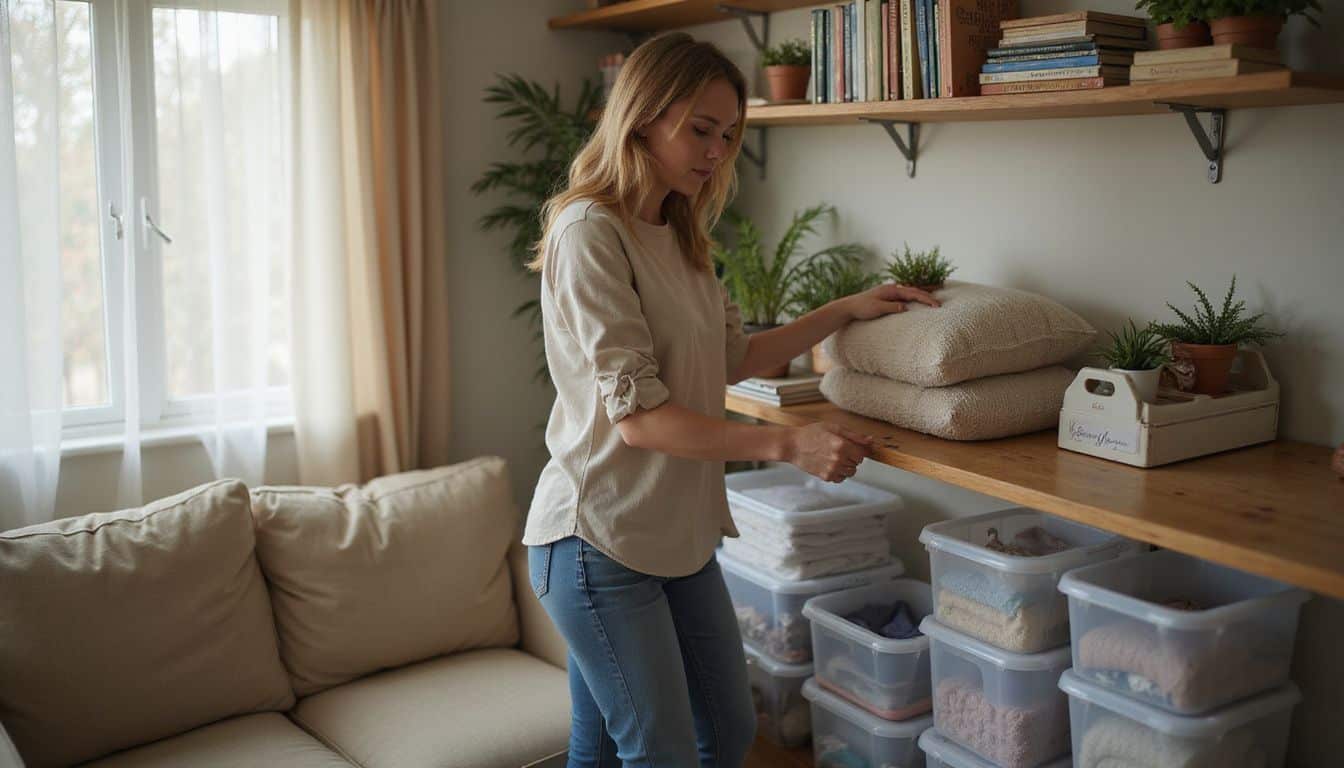
Smart storage ideas, like floating shelves or stackable bins, can help keep a small living room tidy and open—there’s even more inspiration just ahead!
How do built-in storage units help save space?
Built-in storage units use vertical space, making small narrow living rooms feel open and less cramped. Wall-mounted shelves or cabinets keep floors clear, which instantly creates the look of a larger area.
These units fit awkward corners and strange-shaped nooks, so every inch works harder for you. Custom shelving around doors or windows can give easy access to books, games, or even decor while hiding clutter at the same time.
You can divide your living room into different zones with storage walls or built-in bookcases by IKEA. A built-in bench under a window doubles as both seating and extra storage for blankets or toys.
This style organizes everything neatly out of sight yet close at hand—giving your space more order without taking up needed floor area.
How can hanging baskets add extra storage?
Hanging baskets use vertical space, making small living rooms feel larger and keeping floors clear. Install them on walls or even from the ceiling to store remote controls, books, toys, or craft supplies.
These baskets help keep surfaces tidy and organized while adding a touch of style and personality to the room. Many women enjoy how easy it is to move baskets if you want a fresh look or need extra storage somewhere else.
Their open design makes it simple to spot things at a glance, cutting down clutter without another bulky cabinet. Hanging baskets fit well with other space-saving ideas like floating shelves or multipurpose furniture pieces.
They support a minimalist approach by reducing the number of large storage units in your space. Ready for more tips? Discover why concealing your wall-mounted TV helps maintain an uncluttered feel next.
What are the benefits of concealing a wall-mounted TV with a floating media center?
Baskets free up floor space and add flair, but floating media centers take it a step further by hiding away bulky electronics. Concealing a wall-mounted TV with a floating unit cuts down on clutter in tight living rooms.
It keeps wires and devices tucked out of sight, which makes the whole area feel airy and neat.
I tried this setup last year in my own small apartment. A sleek floating cabinet under the TV gave me plenty of storage for remotes, games, even some books—without eating into precious room for seating or walking.
The clean lines made my living space look much bigger than it is. Plus, choosing finishes that matched my shelves helped tie all parts of the room together effortlessly.
Designers love this trick too because you can focus attention on your favorite decor instead of letting the television dominate everything else. With fewer chunky pieces crowding around your screen, arranging chairs and tables becomes easier—a real bonus if you have friends over often or enjoy moving things around to change up your style every season.
How should I arrange furniture and manage traffic flow?
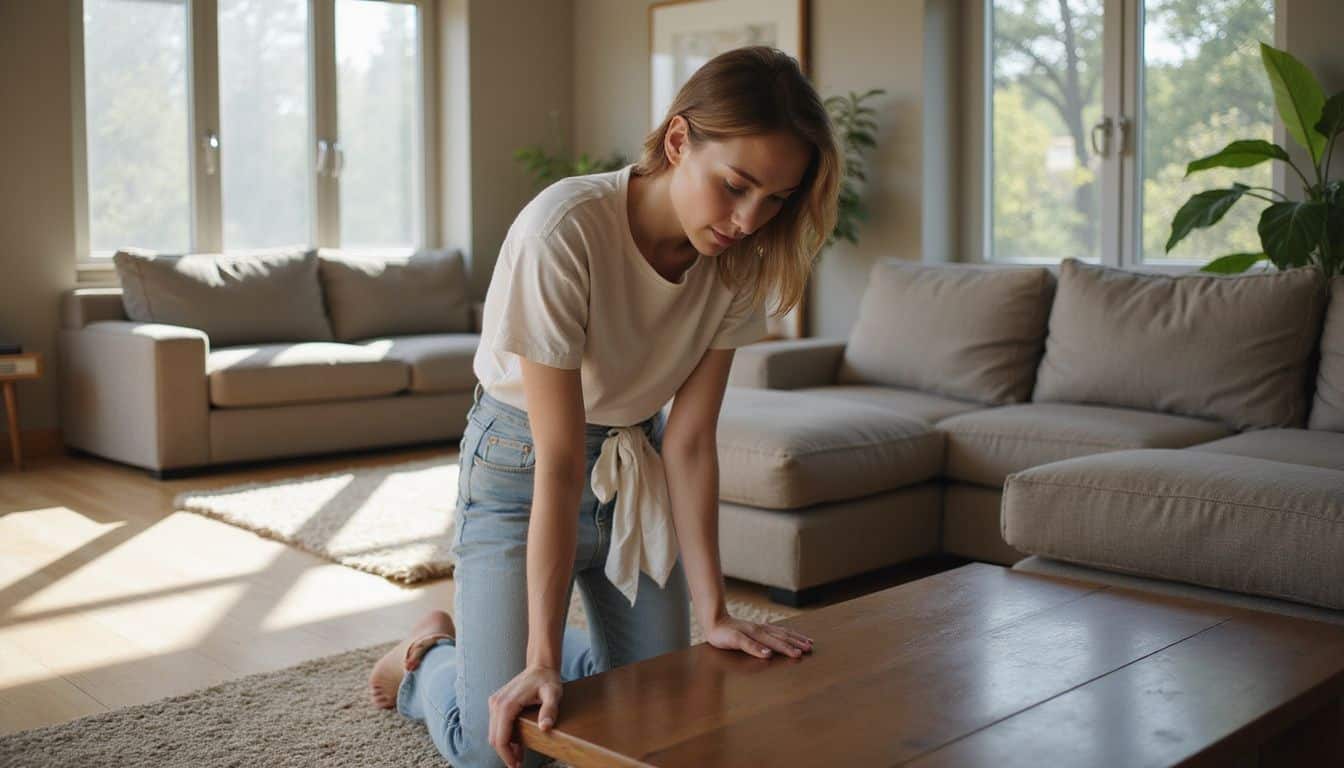
Thoughtful furniture placement helps people move freely, making the space feel open and welcoming. For more ideas on smart layouts and traffic flow, check out how to place furniture in a living room.
How does mixing seating improve traffic flow?
Mixing seating types, like a straight-back couch with accent chairs or movable ottomans, opens up walking space. I have found this trick very helpful in my own home. Smaller chairs or stools near entryways keep paths clear for guests—no more squeezing past bulky couches! Movable pieces also let you switch things around for larger groups, helping everyone find a spot without blocking walkways.
Clear pathways are essential in narrow living rooms. Side tables next to different seats offer handy places to set drinks or books, so people do not gather in one area and slow things down.
Choosing furniture that is the right size makes a big impact too; avoid oversized items because they make spaces feel crowded and hard to move through. Mixing your seating options really helps everyone get around easily while keeping the room stylish and cozy.
Can I place chairs in walkways without blocking paths?
Chairs can go in walkways only if they do not block clear paths. You want to keep at least 24 inches wide for people to move comfortably. Symmetrical setups help balance your space and make sure movement stays easy, especially in small narrow living rooms.
Try using furniture like tapered-leg chairs or folding stools; these look lighter and are easy to shift around as needed.
Multifunctional pieces, such as storage ottomans or benches, work well too. They keep walkways open while offering a spot to sit or stash things away. Keep up with decluttering so chairs and other seats never become roadblocks—you will notice the room feels bigger and air flows better throughout the day.
Why avoid pushing furniture against walls?
Pushing sofas and side tables against the walls can make a small, narrow living room look even slimmer. This layout forms a corridor effect, which cuts off conversation and shrinks your space visually.
I once tried this in my own apartment, and guests moved straight through without pausing to chat or relax.
Placing seating away from the walls helps traffic flow smoothly. Central arrangements create cozy spots for talking and make the room feel much more inviting. Symmetry also looks pleasing to the eye and gives a calm feeling overall.
Light-colored couches reflect sunlight better when they are not stuck by dark corners, opening up any little area you have left.
How to create feature walls and focal points?
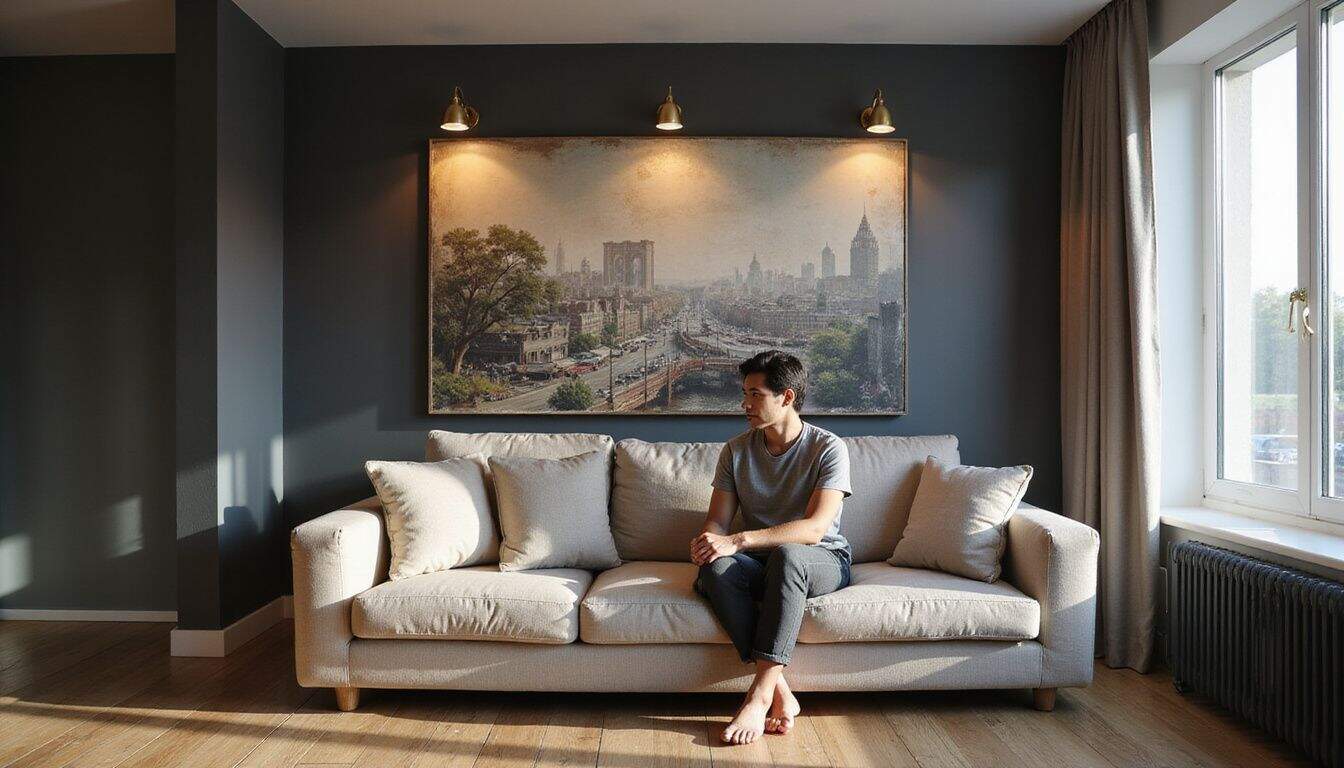
A bold accent wall can draw eyes and add a fresh spark to your small living room. Unique ceiling lights or a striking wall mural may help highlight one area as the true star of your space.
How do wallpapers or paint create a feature wall?
Wallpaper or paint can turn a plain wall into the star of your small narrow living room. Try light colors, like soft gray or pale blue, for an airy feel that opens up the space. Darker tones such as deep emerald create depth and make the room seem richer.
Vertical stripes work wonders; they pull eyes upward and add height to low ceilings—a trick I used in my last apartment with great success.
Choose a bold print or bright color to draw attention away from how skinny your room feels, creating balance. Textured wallpaper adds another layer—think grasscloth or faux brick—for warmth and style without cluttering shelves.
Good lighting highlights these textures at night, making even a tiny space glow and feel cozy. Feature walls set the mood and bring real character into narrow rooms without using extra floor space.
Why add a statement fireplace for coziness?
Paint or wallpaper can truly make a feature wall shine, but a statement fireplace goes even further by creating warmth and drawing every eye. In my own narrow living room last winter, I added an electric fireplace with a chunky stone surround.
It became the heart of the room overnight. The flames made everything feel inviting after work.
A well-placed fireplace acts as your main focal point in any small space. Its design shows off your style—rustic stone for cottage charm or sleek marble for modern taste. By adding textured throws and soft rugs near it, you boost comfort and create layers that everyone feels drawn to on chilly nights.
Arranging chairs symmetrically around the fire keeps things calm and welcoming without cluttering up the floor plan. Extra lighting nearby also helps highlight this cozy spot while making your whole living area seem bigger than it is—especially important in compact layouts!
How can unique ceiling designs highlight the room?
Bold ceiling designs pull attention upward, making your small narrow living room feel taller and more open. Using vertical patterns, such as beams or paneling, can stretch the space visually.
For example, coffered ceilings with clean lines or painted stripes direct the eye and elongate even a compact area.
Distinct treatments turn the ceiling into a focal point that reflects your style and shows purpose in each zone. A matching color palette for walls and ceiling brings everything together; this helps create harmony throughout the room.
Next up is discovering how characterful furnishings add personality to your small space.
What are styling tips for a small living room?

Styling a small living room with clever shelving, soft lighting, and mixed materials can make it feel cozy—check out more tips to boost comfort and style in your space!
How can I keep the space clutter-free?
Start with a deep declutter session every month. Pull out old magazines, unused decor, and kids’ toys. Donate anything you have not used in three months. Limit knickknacks on coffee tables or shelves to just two or three favorite items.
Multifunctional furniture really makes a difference here; my ottoman opens up and hides all the extra blankets after movie night.
Go vertical for storage whenever possible. A tall shelf can hold books, bins for craft supplies, even board games without eating precious floor space. Choose lighter paint like cream or pale gray to keep things feeling open—this trick has worked wonders since I switched from darker tones last fall.
Built-in cabinets under windows give you a spot to tuck away remotes and chargers too, so they do not pile up on side tables anymore. Stick with pieces that work double duty as seating and storage; your living room will feel brighter and less crowded right away!
How do characterful furnishings add personality?
Keeping clutter at bay lets your true style shine. Once surfaces feel clear, it’s time to add those standout pieces that really make the space yours.
Unique coffee tables or handmade cushions draw the eye and set a mood that mass-produced things just can’t match. I love using light fabrics with texture, like a chunky knit throw or velvet pillows, because they bring warmth without crowding the room.
High-quality chairs in neutral shades help stop small spaces from feeling busy while still letting your favorite quirky lamp or an embroidered wall hanging stand out as conversation starters.
Layered lighting shows off these details and creates a cozy vibe each evening—just flip those lamps on and enjoy how every corner feels special. Multifunctional furniture adds personality too; think of an ottoman with hidden storage that displays books by day but props up tired feet at night.
Why use curved edges to soften the room?
Curved edges in furniture, such as oval coffee tables or round cushions, soften the look of a small living room. These shapes break up sharp lines and make your space feel more inviting.
Rounded side tables or circular ottomans also help people move around your furniture with ease, which is great for narrow layouts.
Pieces with curved designs and tapered legs give the illusion of extra space while keeping things light and airy. Curved sofas or chairs can become stylish focal points without making the room feel crowded; they add calmness, too.
Try matching these soft curves with light color schemes to create an open, relaxing atmosphere that truly feels like home.
Multifunctional Ideas for Small Living Rooms
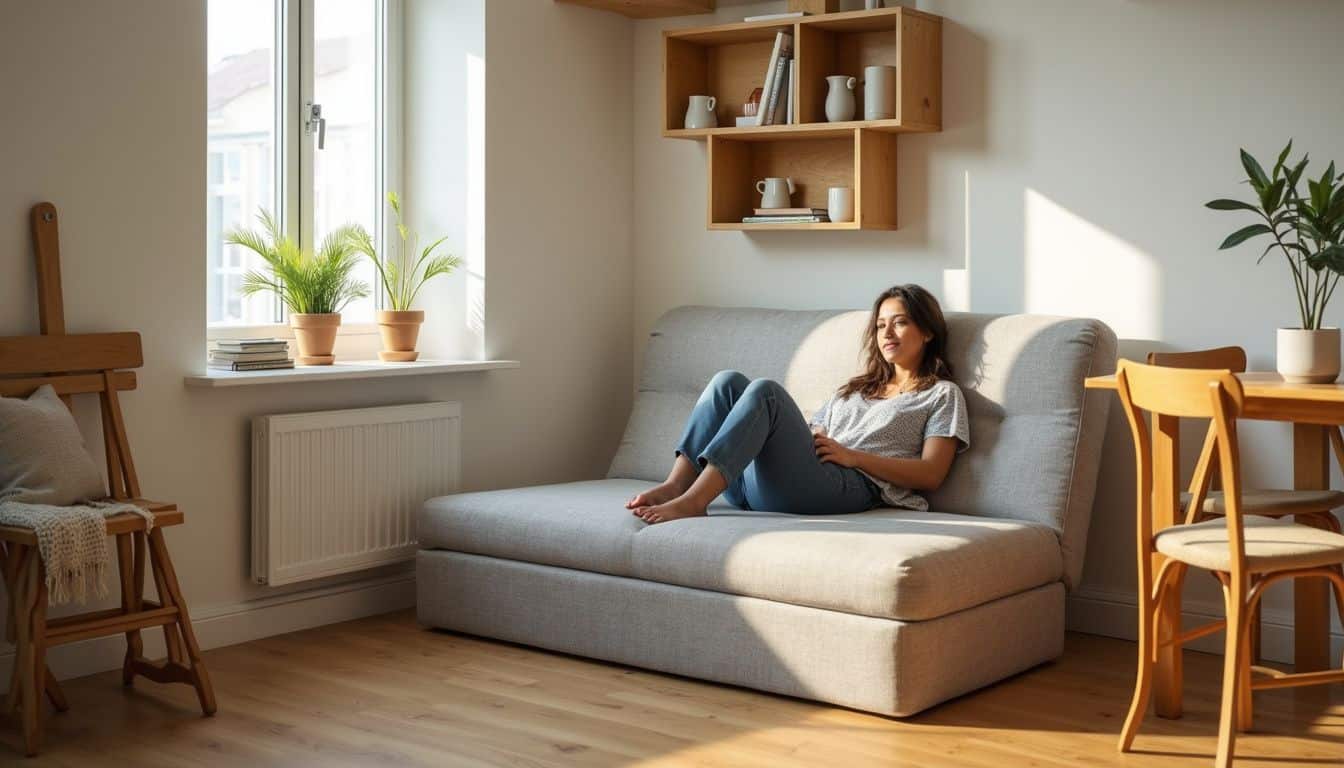
Sharing a single space can be easier when you use multipurpose furniture, such as an ottoman with storage or a folding dining set. Room dividers, like open shelving units or simple curtains, help switch up your layout in seconds and keep life feeling fresh.
How can I combine a living room with a dining space?
Pick a main purpose for the space first. Use zoning tricks to split the narrow room into two clear spots, one for relaxing and one for eating. Place a rectangular rug under your dining table and another under the sofa; this helps mark out each area without walls.
Try a modular sectional or a straight-back couch along one wall to save floor space.
Go with multifunctional pieces like drop-leaf tables or stackable chairs so you can tuck things away when not needed. Storage ottomans work well, too—they stash stuff while offering extra seating in both zones.
Stick with lighter colors on furniture and walls to tie everything together and make the room feel brighter and bigger; use matching cushions across both areas for unity.
I tried using shelves above the sofa that stretched toward my dining corner; this gave vertical storage plus made my tiny living-dining layout look planned instead of cramped. Modular sofas also let me move seats around as needed, perfect for family movie nights or hosting dinner guests in limited square footage.
What versatility does a chaise or card table provide?
A chaise lounge acts as both a comfy seat and a spot to stretch out, making it perfect for relaxing or reading in tight spaces. My own living room feels bigger since I swapped my bulky armchair for one; guests love the extra seating, but it’s still light enough to move if I need more space.
Neutral colors on the fabric help keep things calm and bright.
A card table works well for small gatherings or quick meals without taking up permanent floor space. Fold it away after game night or use it as an art station for kids. These tables are easy to store in closets when not needed, especially helpful in narrow rooms with little storage.
Both options allow you to change your layout fast, keeping your living area flexible and clutter-free.
When should I include a sofa bed for dual use?
Space feels tight? Add a sofa bed to create both seating and sleeping areas without overcrowding your small narrow living room. A slim-profile design maintains an open feel, while multi-functional furniture helps maximize every square foot.
This simple trick, often used by designers like Joanna Gaines for compact interiors, boosts space efficiency and cuts down on excess pieces.
Pick light or neutral colors to make the room appear bigger and keep a calm vibe. Place the sofa bed where it can help mark out zones in multifunctional spaces; this works well in modern apartments or family rooms that double as guest quarters.
Always choose a style that matches your décor so everything looks harmonious and pulled together.
How Will Small Narrow Living Room Design Change in 2025?
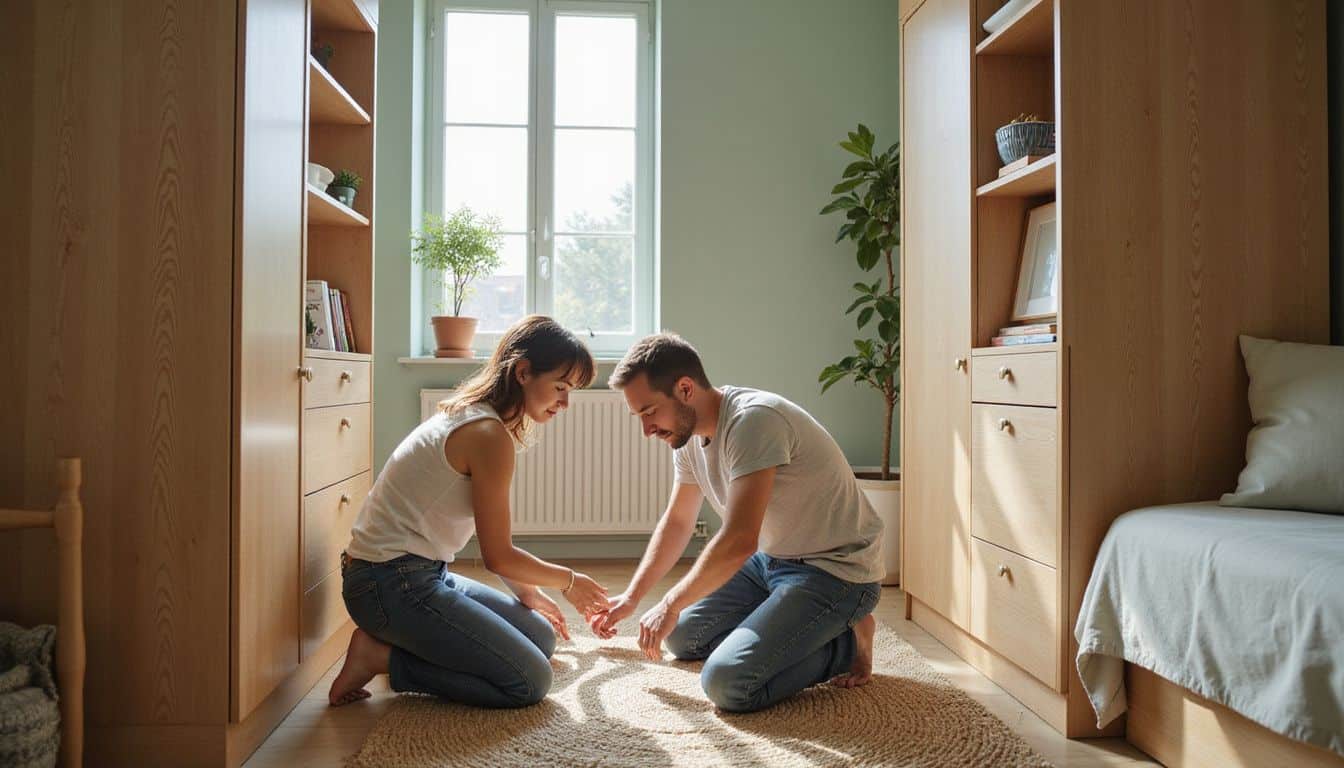
Multifunctional furniture will take center stage in small, narrow living rooms in 2025. Picture a storage ottoman that doubles as a coffee table or a wall-mounted desk beside your sofa with hidden shelves tucked behind it.
I have used these smart pieces at home and they really make daily life easier. Lighter color palettes like soft pastels, gentle creams, and warm light grays will become more popular too.
These tones open up cramped spaces by bouncing natural sunlight around the room, making everything feel fresh and bigger.
Vertical solutions are getting smarter each year. Wall-mounted bookshelves or stacking cabinets help keep floors clear and clutter-free while offering loads of storage for books, baskets, or TV equipment.
Symmetrical layouts will bring calm organization to the space; balancing two accent chairs on either side of a slim console can make everything look tidy without feeling stuffy. People now ask for sustainable materials when picking out seating or tables—think bamboo shelving units or recycled fabric cushions—which last longer while giving a cozy touch to the room.
Mixing textures joins this trend too: combine linen pillows with jute rugs and sleek glass lamps for comfort plus style under one roof! Layered lighting makes every corner glow both day and night using pendant lights mixed with wall sconces instead of bulky floor lamps that steal precious real estate from walkways.
People Also Ask
How can I make a small narrow living room look bigger and stylish?
Use light paint colors, hang mirrors to reflect natural light, and choose furniture with thin legs. Try arranging seating along the walls for more floor space. Add layered lighting to brighten dark corners.
What are clever ways to save space in a narrow living room?
Select multi-purpose pieces like storage ottomans or nesting tables. Mount your TV on the wall instead of using a bulky stand. Pick slim sofas and chairs that fit tight spaces without crowding.
Which decorating tips help add style without cluttering my small living room?
Stick to simple color palettes; use two or three shades at most for harmony. Hang art vertically to draw eyes upward, making the ceiling feel higher. Choose statement pieces—like one bold rug or lamp—instead of many tiny decorations.
Can I create cozy seating in a long, tight space?
Yes; group seats close together around one focal point such as a coffee table or window view for comfort and conversation flow. Use soft textiles like throws and pillows for warmth while keeping walkways clear so movement stays easy throughout the room.
